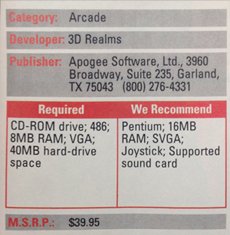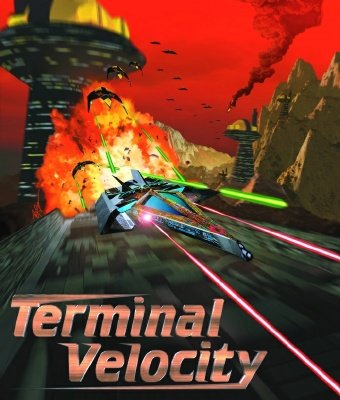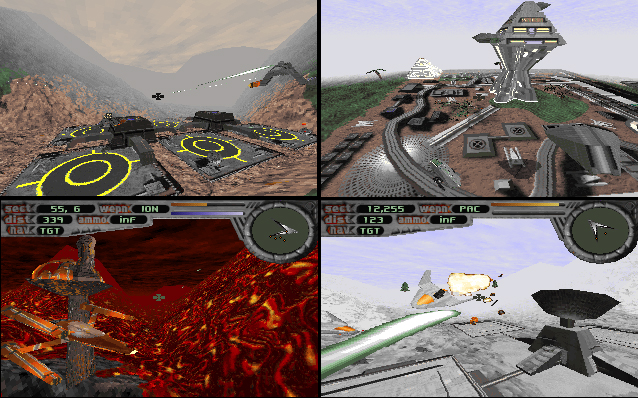Our Verdict
This is a great shoot-'em-up with lots of new worlds to destroy.
PC Gamer's got your back
Tyler Wilde provides commentary followed by the original text of our Terminal Velocity review from the October 1995 issue of PC Gamer US.
It's funny that, at a time when "Doom clone" still meant "any game where you shoot stuff," there was any "just another shoot-'em-up" fatigue at all. Everything was so new; in this review of Terminal Velocity, we compare it to X-Wing, Descent, Magic Carpet, and Shock Wave, and I could throw in Apache and Wing Commander III and a few other air and space combat sims, but it's not as if we were being crushed under a pile of identical games.
Terminal Velocity was exciting just for existing. It was one of my favorite shareware games, and I don't think I ever played anything more than the free episode (the registered version included two more). I never needed to. This review praises the variety of settings, but I was just happy to be mesmerized by the 3D-ness of it. That I could fly around a planet shooting at stuff was bonkers.
To be fair, though, I should credit some of that to youth—I probably also thought Jumanji was amazing. And more importantly, is there any way we can start using "comm-bat" to refer to multiplayer all the time?
Terminal Velocity review
OK, so Terminal Velocity is just another science fiction shoot-'em'up—but oh, what a shoot-'em-up it is!

On September 2nd, 2704, warships from the Earth's surrounding systems descended from the sky and laid waste to eleven major cities, killing millions of people and bumming out several dozen more.
Sol's remaining defenses were assembled in a small retaliation fleet, with you—a TV-202 pilot assigned to the Ares Fighter Squadron—in the lead. After the jump to Bernard's Star, you open your orders and...ah, screw it. None of this stuff matters, does it? All you want to know—all you need to know—is if the game's any good. You bet it is.
Think of Terminal Velocity as a combination of X-Wing and Descent, with a healthy dose of Magic Carpet and Shock Wave thrown in. It's a roller-coaster ride with complete 360-degree freedom of movement, eye-popping graphics, digital sound and the massacre mentality of a Doom clone. It blends elements of flight sim and action in a package that should satisfy people who don't necessarily like either (or who love both).
After a quick briefing on the target planet, detailing your mission objectives and all known enemy ships and targets in the area, you'll jump into the fray with only a dozen or so essential key commands to remember. In case you forget your objective, the goals for each mission are simple enough: destroy absolutely everything along your flight path, then get the hell out.

Simple, yes—but not as easy as it sounds. On anything but the easiest skill level, the opposition is fierce and thick as flies, often striking when you're least prepared. Fortunately, you'll find plenty of weapons and powerups in the debris of vaporized enemies, including the most ass-kicking afterburner you've ever seen.
The acting is, arguable, basic shoot-'em-up fare, but Terminal Velocity gives us new worlds to conquer that are far from standard. Missions take place on eight planets, one asteroid, an alien ship and in dozens of Decent-style tunnels, offering players more than 400,000 square miles of terrain to fly over and through. The setting for each scenario is varied, with hills and valleys characterizing most, and vast cities populating others. These keep the look of the game fresh, and present new challenges as you progress through the game. As a bonus, there's no time limit to the missions, so you can feel free to hunt for targets of opportunity outside your mission path, or just enjoy the scenery above or below the heavy cloud layers of your chosen planet.
For all its graphic and sonic delights, though, Terminal Velocity's arcade approach begins to wear thin after a while—especially when you've had your fill of the miserable, despicable, evil bosses that preside over each level. It's here that TV's multi-player options help extend the mayhem with modem or network "Comm-bat."

Comm-bat allows two players over a modem (or eight players on any IPX-compatible network) to battle it out cooperatively, head-to-head or in teams. Apogee's RemoteRidicule feature, first seen in Rise of the Triad, lets you taunt your opponents with canned .WAV files that you can replace with tasty taunts of your own.
All this gaming goodness rolled into one game does have its price, of course. You're going to need what some witty Brits call a "ninja" system (translation: very fast) to get the most from TV. But as long as you meet the minimum requirements and tweak the detail options wisely, you should be able to get your money's worth.
As it stands, Terminal Velocity is outrageous fun; not entirely original or inventive, but a definite must-have for fans of first-person shooters. — Scott Wolf
This is a great shoot-'em-up with lots of new worlds to destroy.
- Tyler WildeEditor-in-Chief, US


